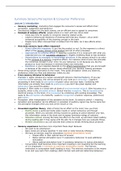Samenvatting
New! Concise Summary Sensory Perception and Consumer Preference (MCB-30806)
This document contains a concise summary of 28 pages for the course Sensory Perception and Consumer Preference (Wageningen University). All information from lectures, articles and reflection meetings is integrated within this summary. The summary contains: - Introduction - Sensory information pr...
[Meer zien]




